I turned up at the airfield early at 09:00, as I wanted to be back by 13:00. So I carefully gave the plane a leisurely A-check. As I would be flying by myself, I decided to fly with nearly full tanks, so off to the pumps to add about 90 litres of fuel. I climbed back in the plane and started up when I glanced at the wings – aaarrgh! I had forgotten to put the fuel caps back on as I got distracted by manually rewinding the hose. I would not have taken off without the caps on as I have an item in the checklist for my power checks to visually check for the fuel caps, but nevertheless that was careless. I have now resolved to put the fuel caps on my seat while I next fuel the plane. That way, I will always notice when I sit back down!
Then I realised that I had taxied across and refuelled but I had not ‘booked-out’ with the tower. I called on the radio and asked if he wanted me to taxi to the stand to book out but fortunately he took my details on the radio. OK, that’s two mistakes so far, NO MORE! When I was learning and early post-PPL, when I made a silly mistake, I would dwell on it and get myself flustered, leading to more mistakes and creating a vicious circle, but in recent years, I have been able to break such circles and stop them developing, well that was going to happen here and now.
I carried out the power checks, making sure to keep the engine high power check as short as possible to ensure that the engine did not exceed the maximum 224 degrees set for the running in period – high power plus low (in this case no) airspeed equals high engine temperatures. Power checks were fine and as I taxi forward to the hold, the tower anticipates my next call and kindly offers me an immediate if I am ready. I accept and line up on 27 and apply full power. The plane leaps forward, tail up shortly and keep a very close eye on the distant centreline ready with the pedals to keep her straight. There is virtually no wind. She starts hopping and we are up. I hold the nose low for a very slow climb so that the airspeed builds to aid engine cooling. I continue the cruise climb, looking for 110 – 120kts. Ten degree right noise abatement turn at the end of the runway and I set track for a straight line between Gloucester and Perranporth. This will take me straight through Cardiff category D airspace, so I have to get clearance.
I climb to 5000’ where I am on top of the inversion layer. Although the sky is clear, it is a high pressure type day and so hazy below the inversion layer and not-great lateral visibility. I call Cardiff and they are OK with a zone transit at 5000’. They ask me to fly closer to the Welsh coast to avoid Bristol airspace (Cardiff and Bristol controlled airspace runs pretty much mid-Bristol channel). I am happy to do this as all I have is a lifejacket and at 5000’, if the engine failed it would be touch and go if I could glide to either shore from mid-channel. Cardiff call me and ask me where I intend to cross the English coast, I am confused for a few seconds thinking ‘but I am not flying in from France, what do they mean ‘English coast’ – then it dawns on me, this whole ‘Wales / England’ thing! I didn’t have anywhere picked out so I grab the map and see where the line crosses the coast. He repeats his request and without thinking I revert to military radio procedure and reply ‘Wait – Out’. He responds with a quizzical ‘Brighthouse???’. Then I recall the correct aviation phrase and say the magic word – ‘Standby’. OK, I will cross at Minehead. Shortly after Minehead on the Somerset coast, Cardiff dispense with me. Initially, I maintain a listening watch on London Information, but they are busy and constant chatter is distracting, so I switch to Newquay Approach who are much quieter. I enjoy the relative silence sitting up here at 5000’ above the inversion watching the changing landscape slip by below.
I monitor the engine readings carefully. The engine temperature is steady at between 191 – 194 degrees. RPM is 2520 and manifold pressure is 23.1. So I am at 75% power. Fuel consumption is (for me) an alarming, but expected 37 litres an hour and indicated airspeed is 165 – 170 kts.
First the beige and brown uplands of Exmoor in Somerset, then the green fields of Devon, then the deserted ex-RAF airfield of Davidstow Moor.
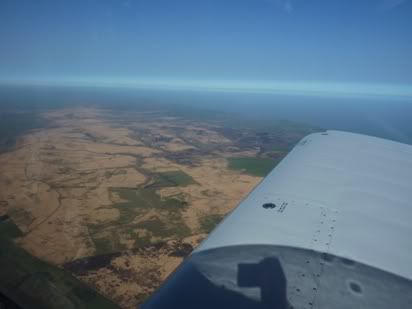
North Devon coast from 5000'
I make contact with Newquay and tell them that I intend to route through their overhead at 3000’ en-route to Perranporth. As they only have a normal ATZ, which tops out at 2000’ AAL, it is of course nothing to do with them, but it is sensible to talk to an airfield if you intend to wander above their airspace. I started a slow cruise descent with a slight reduction in engine power, but still at 65 – 70%. The airspeed is still blazing away at 170 kts. I hurtle through the Newquay overhead and look carefully for Perranporth. Damned if I can see it yet. I switch to Perranporth Radio and gather that they are using runway 23 with right hand circuits, but no mention of the wind. Call them for a wind check, it is 260 at 06 kts – the expected effects of a sea breeze. I wonder why they are not using 27, but I am happy with 23 as it isn’t much of a crosswind.
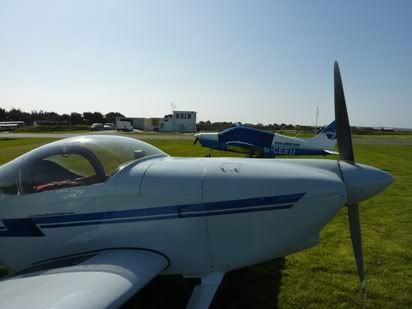
G-GDRV on the ground at Perranporth
I spot the airfield and listen for other traffic in the pattern. I figure that I am OK to join right base for 23 and advise him of my intentions. I now have to pull the power and work hard to get the aircraft to slow down. I do manage it, but predictably leave myself high on final, so I side-slip that off and unwind on short final with a good picture and a good airspeed. I come in to flare, I hear an aircraft behind me calling a go-around (I hope I didn’t cut him up, I thought he was quite a bit further behind me), I hold off, no stall warner yet (bad sign), so I hold off and off and off and it starts to ring (phew!). We touch and stay touched, oh, hey, not bad that one! I trundle to a taxi and have to taxi a fair way to the turnoff of the grass taxiway. The tower are happy for me to park anywhere, so I oblige, park up on the grass and shut down.
I pop the canopy and am greeted by…….silence. Slight onshore breeze and beautiful warm sunshine – wow, what a day! I make my way to the tower, they ask if I need fuel. Need? No probably not, but I could use the weight. They suggest I leave the landing fee until I have refuelled then pay one bill. I head down to the basic but entirely adequate café in the ground floor of the tower. Very friendly guys there and they promptly rustle up the mandatory cup of tea and bacon bap – and yes, they were nice baps!
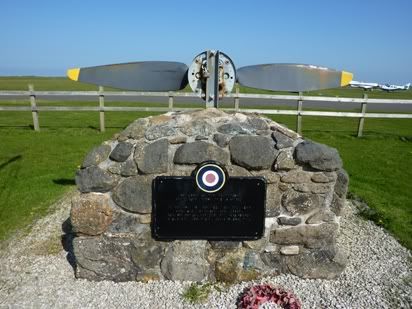
Simple but moving RAF memorial at Perranporth
I walk around outside and chat to go guy at one of the picnic tables. He lives locally and has just started his flying lessons (looks like a mid-life crisis decision like mine!). I spot a Cessna that has just landed, it must have landed long as I can see it still going a fair speed along the runway past the turnoff for parking. I note that his wings seem to be tilting from side to side and I thought it strange as the wind wasn’t that strong. I don’t think anymore of it and turn away. Then I hear the fire land rover starting up and heading out to the plane. It seems to have stopped near the end of the runway, but that’s it. I ask later in the tower and apparently he had made a hard (and fast) landing and seems to have pulled it off the runway to one side (I think it might have been a student).
There is a nice little RAF memorial by the tower to all of the various squadrons that flew from the airfield in WW2. It really is a lovely, basic but very friendly airfield. A bit flat and exposed here on top of the cliffs at 330’. I fill up on Avgas from the pumps. They are near the tower and in an ex-shipping contained located by some ex-WW2 blast bunkers.
I pay up. The fuel is a pricey £1.94 a litre but the landing fee is something like £12 (I can’t remember other than thinking it was what I expected). I mount up and call for airfield information. The wind has freshened slightly to 270 / 10. As I mount up, I see G-BKCC land and park up, a fellow aircraft from Gloucester, but I don’t have time for a chat. I start up and I am about to say that I will take off from the shorter runway 27 (plenty of room at 750m) when they say they are switching to 27 anyway. On the taxi around, I taxi past what must be a locally based RV7 and get a comradely wave from the owner. Brief power checks complete, I line up and power down 27. We are up quite soon and I am rewarded by flying straight over the cliff (only about 200m past the end of 27) for the land to fall away to the beach below.
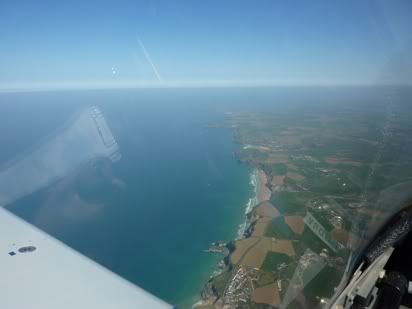
Cornish coast
I start a gentle right hand turn and climb and call Newquay. I am passing 4500’ by the time I get to the Newquay overhead and continue the climb back up to 5000’ for the return flight, following the same route as I did coming out. The plane settles down to the same numbers and I am sat again on top of the inversion layer. Minimal wind according to the groundspeed readout on the GPS.
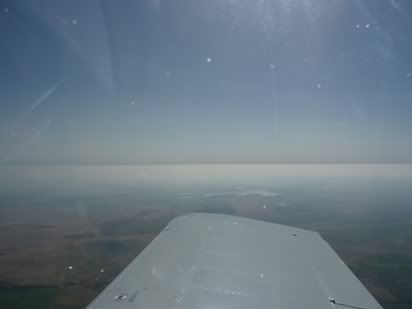
Looking into the sun at the inversion layer
I get a transit of Cardiff after a couple of ‘standby’ – he was pretty busy. At the Severn River crossings Cardiff let me go and I pick up the ATIS for Gloucester and start a very gentle cruise descent. I ask for and am given a direct to final join for runway 04 – the wind is something like 010/02 – minimal. I call at five miles and am given number 2. I slow the plane up now and by the time I am on 2 mile final, I spot the aircraft that I am meant to be No 2 to at the same time as he sees me. He is a twin and must have been flying a wide circuit as it is a toss-up who would be best placed to go to final otherwise. I call for one orbit for spacing and the tower are happy. I start my approach at the end of the orbit. Altitude good, airspeed a bit high. Keep it going. Airspeed still a little high, but hey, I’ve got lot’s of runway to use before I turnoff so I may as well land long. I hold off and bleed the speed off in the flare. Good stall warner and we touch and stay touched. Hmmm… two decent landings in a row, but the I know better than to start getting blasé with the RV6, because it will bite you if you start to get sloppy.
I taxi back to the stand and the sun beats down and without airflow from the vents, we heat up quickly. I am relieved to pop the canopy. As I get ready to put the plane away, a guy pops out from Aeros and asks if this is the plane that went around the world (Manuel has left a large ‘Chasing the Morning Sun’ decal on the fin). I say that the plane has (been around the world) but I haven’t. I explain that Manuel started the group and is still in it. This guy is taking lessons at Aeros and plans to build an RV10. I show him around the plane and point out the ‘nothing special’ nature of the engine and avionics fit (other than of course all the extra tanks and HF radio that were required for the trip). We discuss the merits of the various canopy opening methods and I add my personal preference for a sliding canopy.
I put the plane away. It is 13:00 – Cornwall and back by 13:00 with a leisurely stay on the ground – not bad, but I still can’t wait to get this running-in stuff over with so I can get back to my preferred, leisurely ‘economy cruise’ of 125 – 130kts which sips fuel at 21 litres an hour.
Anyway, a really great and relaxing flight, you really can cover a lot of ground at 170kts!
